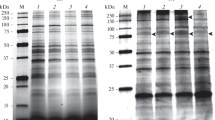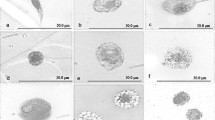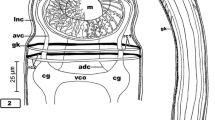Summary
Adult N. brasiliensis incubated in Tyrode's medium released between 3% and 11% of their initial total cholinesterase into the medium per hour; release of enzyme continued for at least 4 hours. Immune-damaged worms, which have much higher cholinesterase levels than normal adults, released 2 to 3 times more enzyme per unit wet weight than did the normal worms. There was no significant difference between the amounts of cholinesterase released per unit wet weight by male and female worms. Adult Nematospiroides dubius released about 1% of their total cholinesterase per hour; i. e. about 1/20 as much enzyme as that released by normal adult N. brasiliensis. These results are discussed with reference to possible functions of cholinesterase in the host/parasite relationship.
Similar content being viewed by others
References
Edwards, A. J., Burt, J. S., Ogilvie, B. M.: The effect of immunity upon some enzymes of the parasitic nematode, Nippostrongylus brasiliensis. Parasitology 62, 339–347 (1971).
Hestrin, S.: The reaction of acetylcholine and other carboxylic acid derivatives with hydroxylamine, and its analytical application. J. biol. Chem. 180, 249–261 (1949).
Keeling, J. E. D.: The effects of ultraviolet radiation on Nippostrongylus muris. I. Irradiation of infective larvae: lethal and sublethal effects. Ann. trop. Med. Parasit. 54, 182–191 (1960).
Lee, D. L.: The fine structure of the excretory system in adult Nippostrongylus brasiliensis (Nematoda) and a suggested function for the “excretory glands”. Tissue and Cell 2, 225–231 (1970).
Lee, D. L.: Changes in adult Nippostrongylus brasiliensis during the development of immunity to this nematode in rats. 2. Total lipids and neutral lipids. Parasitology 63, 271–274 (1971).
Ogilvie, B. M.: Role of adult worms in immunity of rats to Nippostrongylus brasiliensis. Parasitology 55, 325–335 (1965).
Ogilvie, B. M., Jones, V. E.: Nippostrongylus brasiliensis: a review of immunity and the host/parasite relationship in the rat. Expl. Parasit. 29, 138–177 (1971).
Sanderson, B. E.: Acetylcholinesterase activity in Nippostrongylus brasiliensis (Nematoda). Comp. Biochem. Physiol. 29, 1207–1213 (1969).
Sanderson, B. E.: Cholinesterase activity in some species of Strongyloidea and Oxyuroidea (Nematoda). Comp. gen. Pharmac. 2, 469–472 (1971).
Sanderson, B. E., Jenkins, D. C., Phillipson, R. F.: Nippostrongylus brasiliensis: relation between immune damage and acetylcholinesterase levels. Int. J. Parasit., 2, 227–232 (1972).
Sanderson, B. E., Ogilvie, B. M.: A study of acetylcholinesterase throughout the life cycle of Nippostrongylus brasiliensis. Parasitology 62, 367–373 (1971).
Standen, O. D.: Chemotherapy of helminthic infections. In: Experimental chemotherapy, vol. I (R. J. Schnitzer and F. Hawking, ed.). New York and London: Academic Press 1963.
Thorson, R. E.: Studies on the mechanism of immunity in the rat to the nematode, Nippostrongylus muris. Amer. J. Hyg. 58, 1–15 (1953).
Author information
Authors and Affiliations
Rights and permissions
About this article
Cite this article
Sanderson, B.E. Release of cholinesterase by adult Nippostrongylus brasiliensis in vitro . Z. Parasitenk. 40, 1–7 (1972). https://doi.org/10.1007/BF00329610
Received:
Issue Date:
DOI: https://doi.org/10.1007/BF00329610




